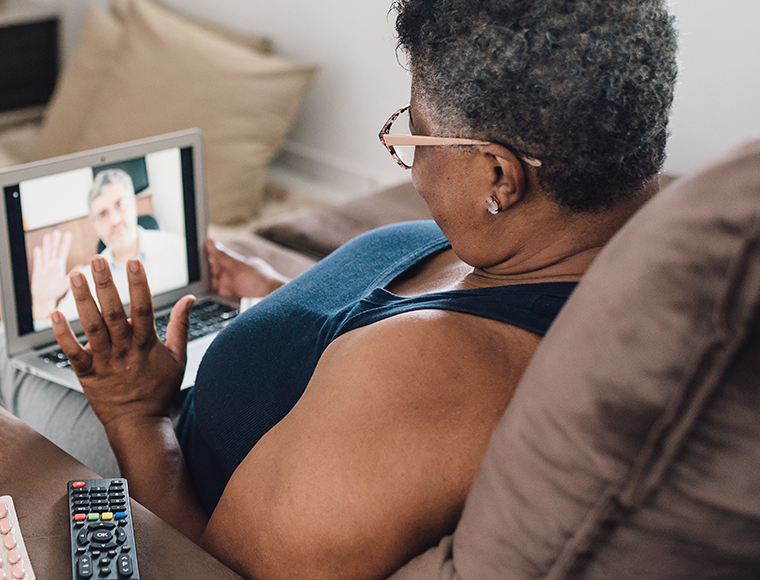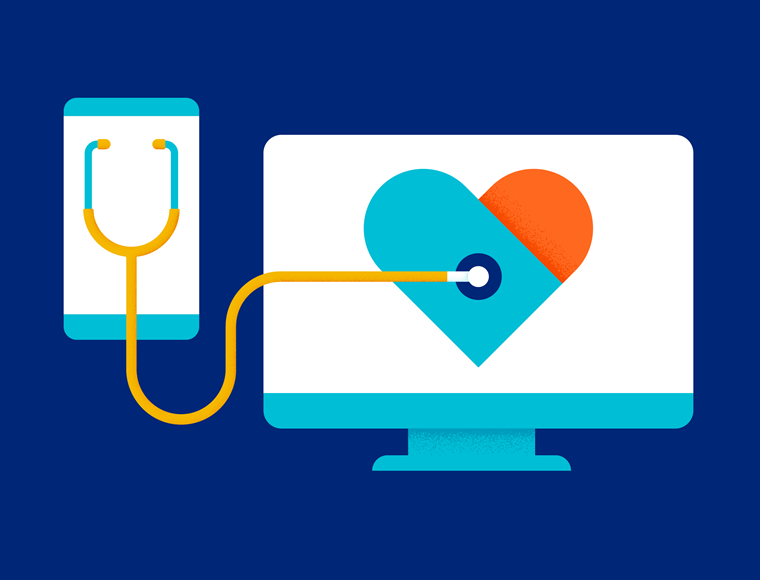The public health emergency (PHE) significantly accelerated telehealth adoption, forcing reforms to federal and state policies to maintain access to needed care while reducing exposure to COVID-19.
As we approach the potential end of the PHE, we look at how the use of telehealth and other digital platforms have impacted care for individuals with Medicaid and discuss opportunities to build upon these experiences moving forward.
Use of telehealth for Medicaid during the pandemic
Telehealth is a clinical tool for delivering care and health education virtually. It can include live two-way interaction via video or audio (synchronous), pre-recorded information (asynchronous), remote patient monitoring and mobile health platforms. When used effectively, telehealth can enhance consumer access and the care experience when in-person care is not clinically necessary. Telehealth tools can also strengthen the connection between patients and providers to improve quality and health equity while reducing the total cost of care.
Virtual care has allowed many individuals with Medicaid to access services more conveniently. For example, many provider partners have reported a reduction in no-show rates as telehealth gives patients flexibility around competing work and childcare priorities as well as removes the reliance on transportation to get to appointments.
One federal survey found that individuals with Medicaid (29.3%) and Medicare (27.4%) coverage used telehealth at greater rates during 2021 than individuals with private (20.7%) or other health insurance (25%). Black individuals (26.8%) and those earning less than $25,000 (26.7%) were the race/ethnicity and income level with the greatest rate of telehealth usages.1
Given the rapid adoption of telehealth, it will be valuable for states and Managed Care Organizations (MCOs) to employ metrics to monitor effects of telehealth and digital platforms on access, quality, health equity and consumer satisfaction.
Growth in behavioral health and audio-only technology
Before the pandemic, only a third of total visits to behavioral health specialists were via telehealth. U.S. Department of Health and Human Services statistics show a 32-fold increase during the pandemic. Many believe the reason behind the increase in behavioral health visits via telehealth is because it reduced the stigma that can sometimes be associated with behavioral health care.
Another area that saw a significant increase was audio-only appointments. Some studies since the pandemic have shown a particular increase in usage of audio-only appointments by lower income individuals, people of color and older individuals.
Significant disparities were identified among subgroups in terms of those who used video versus audio-only. Video telehealth rates were lowest among those without a high school diploma, adults ages 65 and older, and Latino, Asian and Black individuals. Many providers, payers and consumer groups are reporting that audio-only appointments have helped to reduce disparities for those who do not have access to broadband internet or the technology needed to facilitate a live video appointment.
Opportunities to leverage virtual care experience after the PHE
States have significant flexibility and opportunities to design and shape telehealth programs and policies following the PHE. As they draft their long-term policies, they will also be able to continue to expand upon information gleaned during the PHE as many insights are still forthcoming. Additionally, states should allow for the time it will take to continue to build out telehealth and digital infrastructures.
State should consider the diverse needs and preferences of their communities and create space for ongoing innovation to improve outcomes as they shape telehealth programs. To achieve this, they should consider permanent reforms that:
1. Ensure member access, choice and satisfaction
Medicaid members have reported positive experiences with telehealth. To best meet members' needs moving forward, states should consider:
- Encouraging MCOs and stakeholders to offer members accessible and culturally responsive education on telehealth options and best practices for maximizing a telehealth visit.
- Reimbursing for translation and interpreting services including when services are delivered via telehealth.
- Removing geographic or originating site restrictions.
- Expanding the network of available providers to meet local care needs using interstate licensure for health care professionals.
- Supporting the delivery of school-based health services delivered via telehealth, particularly behavioral health services.
- Promoting programs and partnerships to collectively address the digital divide.
- Partnering with MCOs to continue building networks that ensure members have physical access to providers when possible, supporting access and respecting member preferences.
2. Enable providers to sustain and strengthen virtual care capabilities
Providers have invested considerable time and resources implementing virtual care tools and associated clinical workflows over the past two years. These have created efficiencies and enhanced care experiences for consumers and providers. To allow providers to sustain these new points of access and effectively engage Medicaid members, states should consider:
- Reimbursing providers for:
- Services delivered via telehealth that are within their scope of practice and that align with national clinical guidelines for telehealth.
- Remote patient monitoring where it is clinically proven and appropriate to equip providers with additional clinical information and tools that will effectively deliver services remotely and improve disease management.
- Provider-to-provider consultations, including e-consults that leverage telehealth modalities (such as store-and-forward), when a professional medical opinion is sought in order to increase access to specialty care and better equip primary care providers.
- Services that can be delivered appropriately via audio-only to maintain access for consumers without adequate broadband or technology to facilitate a live video visit. These should include outpatient evaluation and management services and professional outpatient mental health care.
- Allowing federally qualified health centers (FQHCs), rural health clinics (RHCs), Indian Health Service clinics (IHS), and community mental health centers (CMHCs) to serve as both origination and distant site providers to promote the equitable adoption of telehealth.
- Working with MCOs and other stakeholders (e.g., telehealth resource centers, provider associations) to collectively assess telehealth capacity, and educate providers on best practices for telehealth and Medicaid coverage and reimbursement policies.
3. Empower MCOs to meet members' needs and uphold program integrity with innovation and collaboration
MCOs play a key role in supporting states, providers and members navigate that evolution of PHE as more information develops. For MCOs to successfully contribute to long-term improvements in access and quality, states should consider:
- Enabling MCOs to create innovative reimbursement models.
- Working with MCOs to review evidence-based practices and employ metrics to monitor effects of telehealth and digital platforms on access, quality, health equity and member satisfaction, and adapt policies accordingly.
- Allowing MCOs the flexibility to leverage their provider networks to help consumers access telehealth services from providers who deliver high-quality care, including allowing for virtual provider access to be factored into existing network access and adequacy standards.
- Enabling MCOs to use tools and capabilities (both pre-payment and post-payment) to preserve limited resources and maintain confidence in the Medicaid system by preventing and addressing fraud, waste and abuse.
- Allowing MCOs freedom to refine utilization management and prior authorization criteria for services provided via telehealth to ensure that consumers receive seamless support, while minimizing administrative burdens for providers.














